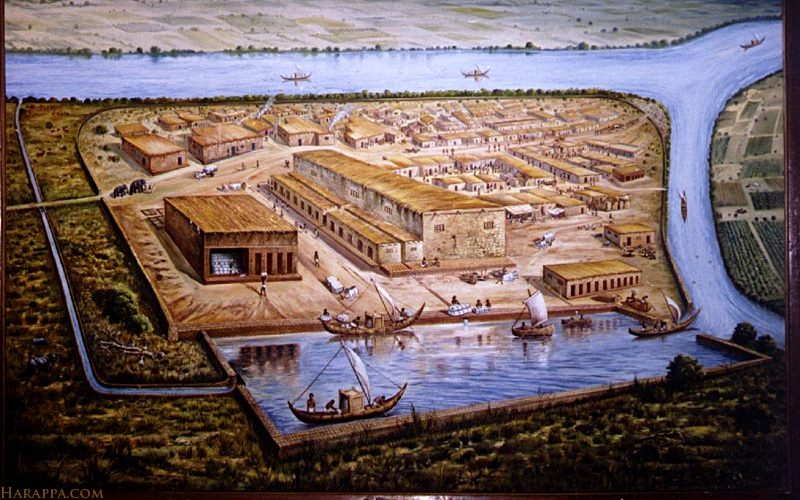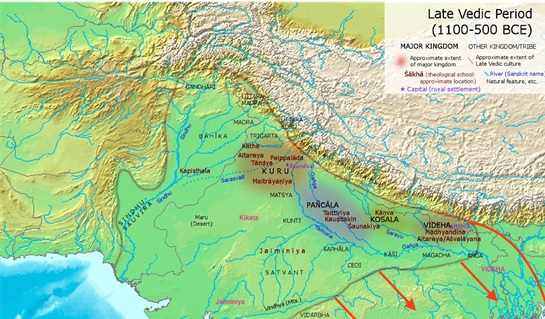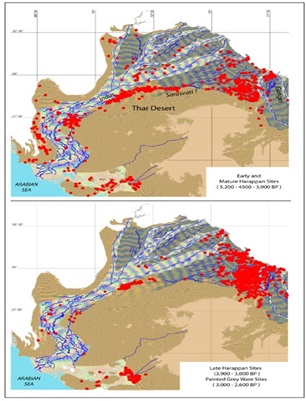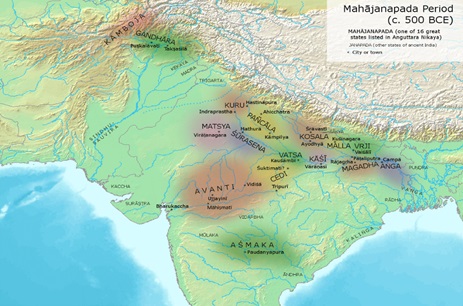Sri David Frawley once noted a highly anomalous paradox in Indian history. On the one hand, we had the largest Bronze Age civilization of the world. The Sindhu-Sarasvati civilization (SSC). It was many times larger in its geographical extent than contemporary Mesopotamia and Egypt put together. It had a population estimated at around five million. That number hovered anywhere around 20% of humanity in 2000 BC.
Yet despite this massiveness of its praja and samrajya, the ruins of the Sindhu and Sarasvati appear dumb and speechless, their uncracked aksharas appear hollow and silent. They have nothing to tell us, who they were or what happened to them, despite their greatness.
On the other hand, we also have the largest and most sophisticated literature from the Bronze Age. The Vedic corpus. Its massive scale, its literary evolution, its philosophical, mathematical and astronomical content and their progression is unrivalled in the ancient world. It describes great kingdoms, trade, horses, chariots, elaborate fire altars, technological innovations, astronomy, standardized units of measurements, sea faring, and agriculture and so on. Yet, there is nothing in the archaeological record to account for such an advanced civilization. Certainly not in 1500 BC, when Max Mueller tells us with colonial command that all Vedic texts only begin to be composed. Not a single Sanskrit text in India can be older than this date, Herr Mueller assures us. But that is not a discussion for now.
This is known as the ‘Frawley’s Paradox’. The SSC silently cries out pitiably for a single word to call its own, for a single uttered sound in its memory. And the Vedic texts shout desperately for a single brick to rest on and to validate itself.
But for once, if we abandon the irrational baggage we have inherited from the colonial era, if we just take a fresh look at the facts and appraise anew all the evidences gathered in these hundred years, remarkable and beautifully natural conclusions will emerge. No doubt they will upturn many dogmas passed on as historical facts, but the joy of realization will be true and immense. One such is a reference to a great migration recorded in the Shatapatha Brahmana, in the fourth adhyāya of its first kāṇḍa:
Mâthava, the Videgha, was at that time on the (river) Sarasvatî.
He (Agni) thence went burning along this earth towards the east; and Gotama Râhûgana and the Videgha Mâthava followed after him as he was burning along. He burnt over (dried up) all these rivers.
Now that (river), which is called ‘Sadânîrâ,’ flows from the northern (Himâlaya) mountain: that one he did not burn over. That one the Brâhmans did not cross in former times, thinking, ‘it has not been burnt over by Agni Vaisvânara.’
Now-a-days, however, there are many Brâhmans to the east of it. At that time it (the land east of the Sadânîrâ) was very uncultivated, very marshy, because it had not been tasted by Agni Vaisvânara.
Now-a-days, however, it is very cultivated, for the Brâhmans have caused (Agni) to taste it through sacrifices. Even in late summer that (river), as it were, rages along: so cold is it, not having been burnt over by Agni Vaisvânara.
Mâthava, the Videgha, then said (to Agni), ‘Where am I to abide?’ ‘To the east of this (river) be thy abode!’ said he. Even now this (river) forms the boundary of the Kosalas and Videhas; for these are the Mâthavas (or descendants of Mâthava).
Now this might appear to be merely a few lines from an obscure text. But the quality and quantity of inferences these rather explicit words allow us to draw is unparalleled in Vedic literature. Let us draw these inferences line by line, name by name.
But first it is imperative to understand the historical position of the SB vis-a vis the other Vedic texts. It is considered as the youngest brahmana. And the brahmanas, broadly, is anterior to the Aranyakas and Upanishads. It is also important to note that the above historical description appears to be a recollection of a past event, rather than a contemporary reference. So this event may actually have unfolded at a deeper layer of the brahmana age.
1. Mâthava, the Videgha – We do not know more about this very ancient maharaja than what the SB tells us. But the word Videgha/Videha rings a lot of familiar bells. It was a kingdom of the Mithila region during the mahajanapada And the most famous philosopher-king from this janapada was Janaka. So renowned was he that the dynasty itself was subsumed by that name and almost all kings of Videha came to be called ‘Janaka’. Many distinct Janakas find mention in the Upanishads, Puranas, Ramayana etc. They cannot all be one person. And the SB clearly states that the dynasty during it’s time of composition was known by the patronymic of Mathava. Until of course, one of his descendants, Janaka, attained even greater fame that surpassed his. So much so that Mathava was completely forgotten in subsequent texts.
Conclusions
-Mathava Videgha was an early king of the historically well attested iron age Videha janapada.
– Sometime in the upanishadic age, succeeding or concurrent with the late Brahmana age of which the SB is representative, Janaka replaced Mathava as the patronymic.
2. ‘was at that time on the (river) Sarasvatî’ – There really isn’t any double meaning or mythical undertones to this unless one is pressed by bias to defend the colonial dogmas. It is forceful and straightforward, requiring no elaboration. The existence of the Sarasvati river, it’s identity with the dried bed of the Ghaggar-Hakra and its approximate hydrological history have all been well researched by multiple disciplines and are known beyond reasonable doubt. It is no longer open to debate.
Conclusions
-Mathava and his people once lived in a kingdom called Videgha located somewhere along the banks of the Sarasvati river.
– Sarasvati was still likely a flowing river, perennial or not, during the time of Mathava. This has implications for dating the event, as many would know. This squarely places the exodus of Mathava at least ~2000BC or earlier times.
– In short, the very well attested Videha janapada has some serious, unrecorded or forgotten prehistory.
In the picture below, it is obvious that the Videhans had to migrate a long way to arrive at their historical habitat of Mithila. They occupied one of the easternmost janapadas.
3.‘.. thence went burning along this earth towards the east’ – Where metaphors appear, there also opens room for interpretation, and uncertainty. Even so, Agni burning the earth and rivers eastwards is, by the simplest explanation, a testimony to the prevailing drought like conditions which also helps explain why a king must make such a drastic journey, leading his people in an epic exodus eastward, abandoning even the holy banks of the Sarasvati.
Conclusions
-There was an exodus and it was probably a consequence of drought, failing agriculture or some other drastic condition that challenged the very sustenance of the Videha people.
-The direction of migration is from west to east. This is of vital importance in looking for archaeological validation of such an event. And because many a Muellerian-Marxist historian has hastily interpreted this passage to exemplify the famed ‘Aryan invasion’- having completely failed to find any support for it from any Vedic text, least of all in the oldest Rig Veda.
-Archeology knows and admits of only one such migration eastwards. The migration of Harappans. A unique and rare moment in the study of history anywhere, when literature and facts on the ground so perfectly agree and complement each other.
The representation below depicts the unmistakable shift of settlement density eastwards during and after the late Harappan period.
4. ‘..and Gotama Râhûgana..’ – These are the single most important two words in the passage. More instructive and replete with imports than the rest of the passage put together. What could possibly be so great about a name of an unknown purohita of an unknown raja? -You might ask.
Everything! His name appears in the anukramani of the Rig Veda(RV)! For those aware of what this means, it will bring tears of joy. For those unaware, the anukramani or indices of the RV give us fundamental information about the rishis who authored the suktas, the chhanda used in each of their composition and the devata or deity of each hymn. Gotama Rahugana is the author of hymns 74-93 of book 1 and hymn 31 of book 9. This means, to cut a very long story short, Gotama Rahugana and his patron Mathava Videgha lived in the middle Rig Vedic age.
Below is a verse composed by him preserved in book 1 of the Rig Veda.
“O Jatavedas(Agni), keen and swift, Gotama with sacred song exalts thee for thy glories’ sake.
A pleasant song to Agni the son of Rahūgaṅa has sung:
We laud thee for thy glories’ sake.”
-Gautama Rahugana, Rig Veda 1.78.1,5
It is beyond the scope of this article to explain how the ten books are arranged by their chronology and antiquity. The reader may refer to “Rig Veda – A historical analysis” by Shrikant Talageri for this. For now, let it suffice to know that book 6 is the oldest and book 10 is the youngest. This is a generally accepted scheme agreed by a consensus of scholars. The Rig Vedic books go in this order-
VI –> III –> VII –> IV –> II –> V –> VIII –> IX –> X
Based on this, and a rigorous comparative analysis of the historical content of the RV, its history has been divided into:-
- Early period- Books VI, III and VII.
- Middle period- Books IV and II.
- Late period- Books V, VIII, and IX.
- Last period- Book X which stands conspicuously apart from the others on many counts including its language.
Book I has hymns composed by descendants of rishis from the oldest three as well as those contemporary to the next three. Its historical position is right after the first three, slightly preceding and contemporary to the next three. It is a chronologically “stretched” book. Book IX, is an even more stretched book. It has hymns by the rishis of the last few suktas of books I, V and VIII (including the Gotama of our present fascination) as well as wholly new rishis appearing only in books IX and X. We can say Books I and IX share more than just Gotama Rahugana.
Conclusions
- Gotama Rahugana and his patron Mathava Videgha lived during the middle period of the RV, perhaps toward the end of this period, when the RV was still only half complete.
- The Brahmana age is not a chronological successor of the Rig Veda samhita, but the beginnings of the former and the middle, late and last periods of the latter are likely contemporaneous.
- This is NOT an Aryan invasion/migration of any sort. If it were, we would expect Gotama to be a rishi of the oldest books (VI, III & VII), at a time when Aryan invaders/migrators would have been just entering North India for the first time (as per that collapsing theory). The oldest books actually have hymns composed by the ancestors of Gotama!
- This was a migration within the Vedic culture which was entrenched deeply in the Sindhu-Sarasvati valley. And it happened before the period of the SB. Further evidence is required to conclude if it was contemporary to an older brahmana such as Aitareya.
- The SB is contemporary to the late, last or post Rig Vedic period. Further evidence is required to conclude.
- The older Brahmanas such as Aitareya are thus a very parallel development to the RV samhita at least since the middle period. Their exact chronological positions vis-à-vis the RV, also with each other as well as to the Harappan archaeological record needs to be investigated.
5. “That one(Sadânîrâ) the Brâhmans did not cross in former times..”– This would imply that there were attempted migrations deeper into North India from the Sindhu-Sarasvati valley even before the time of Mathava and Gotama and that small Vedic settlements already existed in the territories the Videhans were migrating to. Wanting further details, pressing this further would only be a speculative effort. In any case, the passage attests that contemporary Vedic settlements already existed in lands east of Sadânîrâ during that time. The Sadânîrâ is identified with the modern river Gandak, a tributary of the Ganga.
But more interestingly, yet again, we see that some of the most startling archaeological discoveries of recent years are in perfect agreement with this. Varanasi has an antiquity approaching Harappan and mature Harappan civilization and its kiln fired brick technology extended as far east as Raghopur Diara near Patna! Who knows what else remains to be unearthed and where. The borders need to be redrawn, to say the least.
And Mithila region where the Videhans settled is so tantalizingly close to all these palpable discoveries. Unearthing the oldest layer or evidence of new settlements in Mithila would no doubt help us find proper material dates for Mathava, Ragugana, the Brahmanas and even the Rig Veda.
Conclusion
- The migration of Videha was only one of many waves of Harappan expansions eastwards beginning perhaps in the Mature period.
Which of the other historical janapadas made similar journeys? Which of these ancient Indian kingdoms and republics were once located on the banks of the Indus and the Sarasvati? Fascinating questions indeed. Except for a few of them, it is very difficult to answer without stepping into the speculative.
6. ‘At that time it (the land east of the Sadânîrâ) was very uncultivated, very marshy,’ – Another important sentence. A firm testimony to some of the subtle details crucial to our understanding of that elusive age as well as existential questions about the cultural character, societal attainments of the Indo-Europeans who spread Vedic culture and also the mechanics of that process. Two very significant facts are revealed by this sentence.
First, it condemns to the trashcan the mainstream model which has held for the last one century that the people who brought Sanskrit to North India were pastoralists from central Asia. They were nomads who grazed cattle and rode horses. Little more. But Mathava and his people were not mere cow-herders. And they were certainly not nomads. They were a settled lot, for a long indeterminate time before this exodus. They had a kingdom. They practiced agriculture as their primary occupation. And had rituals with elaborate fire altars. The brahmana texts know of brick technology, standardized units of measurement and a lot more. Even the Rig Veda knows of sea faring.
So much so that their first concern on having to migrate into new lands is that it was all marshy and uncultivated! And unsacrificed on. And not in the least that there was no grass for their horses. They were a rajya before they migrated, and they were a rajya when and long after they crossed the Sadânîrâ; they had already evolved into statehood. Later they would evolve further and merge into the powerful Vrijji Republic, one of the sixteen mahajanapadas! Videha completed a full and early political evolution into a republic! Of which there are so few examples in the ancient world. There was no Greece or Rome or any state in Europe when Mathava’s ancestors ruled Videgha somewhere in the SS valley. What was the western scenario during the time of Mathava? It was filled with small farming communities, aggressive steppe pastoralists and even some hunter gatherers.
The tribal identity that the Steppe herders and most other IE tribes of that time no doubt were defined by, had long since been exceeded by the Vedic people. Such a nomadic, tribal past is already unrecorded prehistory as far as the RV is concerned. One would have to torture the earliest verses of the RV to make them admit of it. Makes the inquiry into the true antiquity of Indo-Europeans in the Sindhu-Sarasvati valley a critically important one.
Not only is this not an invasion of Kurgans from central Asia, the Videhans are nothing like them. This throws many cavalier assumptions about Vedic culture to doubt. More groundbreakingly, it forces the honest enquirer to face that paradox of Frawley again.
The second amazing fact the sentence drives home and thereby forces another fundamental Aryan invasion assumption to bite the dust, is that these migrating Aryans were quite lonely in North India then. The AIT/AMT requires us to believe that millions of late Harappans still lived in Indus and Gangetic valleys while the Indo-Aryans invaded or ‘trickled’ through them. In fact, the seasoned archaeologist will assure us that at no point of time was there a notable break in human habitation in broad Bronze Age north India nor any sign of contact between two different material cultures, native and alien. Yet the literary evidence shows that the Vedic Aryans were quite alone in both the Indus and Gangetic valleys. The Videhans did not come across a single foreign or linguistically different tribe at any point of their great exodus from the Sarasvati to the Sadanira. At best the SB hints that there were earlier Vedic settlements here and there. Other than that, it was all a plain, uncultivated and marshy land. There was no one occupying the Gangetic plains. There is no evidence of linguistic transformation involved let alone a dramatic invasion. The Videhans were expanding against a demographic vacuum- so were the Harappans in the archaeological record.
So on what basis was it claimed for the last hundred years that the Harappans and Vedic Aryans are two different people? Wishful thinking and pure speculation. One outrageous theory invented to support another outrageous theory. There is no place for facts, inference or evidence in their stiff orthodoxy. Or they should attempt to answer this- Where did millions of Harappans vanish to? The elephant in the room that the Muellerian school of scholars have tactfully managed to ignore and masterfully gotten away with.
Conclusions
– The Rig Vedic Aryans, of which the Videhans are one, are agriculturists and a civilized lot, not pastoralists.
– They were highly evolved politically and not nomadic or tribal.
– They were not invaders. They were expanding into unoccupied virgin lands.
-There were no other tribes occupying the Gangetic valley and no evidence of any sort of conflict involved in the process.
– Indo-European is the oldest detectable linguistic layer in North India- despite millions of Harappans who spoke something else(according to Mueller’s school of history) supposedly living all over the place.
–Vedic Aryans= Harappans. Resolving Frawley’s paradox, we realize that this expansion of Videhans is nothing but one wave of the Harappan dispersal which is well attested archaeologically.
7. “Even now this (river) forms the boundary of the Kosalas and Videhas.”– The passage finally arrives upon the contemporary scene. The north Indian political scenario henceforth is very much what most of us are familiar with after our years of schooling. There were mahajanapadas. By the time of the Buddha, there were sixteen of them or more. It is also explicitly implied and likely that the people of Kosala also made a similar journey as Videha and they settled right next to the Videhans. Which of the other mahajanapadas also made similar migrations(and were once kingdoms of the SSC) is a fascinating topic requiring further research and is yet unanswerable conclusively.
Conclusions
-The constituents of the Sindhu-Sarasvati civilization was arguably very similar to the later day mahajanapadas. Or were at least their direct forbears in an ethno-political continnum.
– Videha was one of the kingdoms in the Sindhu-Sarasvati civilization. Kosala was probably one too. Locating where exactly in the SSC they came from needs further research. Likely, it may never be found. The reconstructed course of the Sarasvati in the picture below shows the overwhelming number of sites located on its banks. It is not an exaggeration to suggest that one of these ruins along the lost river may well have been the city of the Videhas, where Mathava ruled.
– Other candidate janapadas which may have also once been SSC states are those which find mention in Vedic texts older than SB and who yet survived into the historic period. These include the Kuru, Pancala, Matsyas etc. The former two are descended from the Paurava-Bharata dynasties of the RV.
As we have seen, the darkness and silence shrouding the Vedic/Harappan history is not only possible to dispel, doing so will yield us marvelous insights and clarity of understanding into most enigmatic and underappreciated ancient civilization. All that needs to be done is to abandon the piled heaps of biases and baseless speculations. To clean the slate of colonial chalk and look afresh at whatever evidence there be. To not burden South Asia studies with Steppe baggage or any other extra-territorial theories- or at least not before we give it a fair independent treatment of scholarship. To follow the scientific method and declare to ourselves, ‘here are the evidences, what conclusions can we draw from them?’
References
Colin McEvedy & Richard M. Jones, 1978: Atlas of world population history
Srikant Talageri: Rig Veda a Historical analysis
David Frawley, Georg Feuerstein, and Subhash Kak, 1995: In search of the cradle of civilization.
Swami Ranganathananda, Ramakrishna Math: The message of the Brhadaranyaka Upanishad.
E. Pargiter, 1922: Ancient Indian historical tradition.
Harvard oriental series- Vol 25: Rig Veda Brahmanas- Aitareya and Kausitaki Brahmanas
Featured Image: Harappa.com





